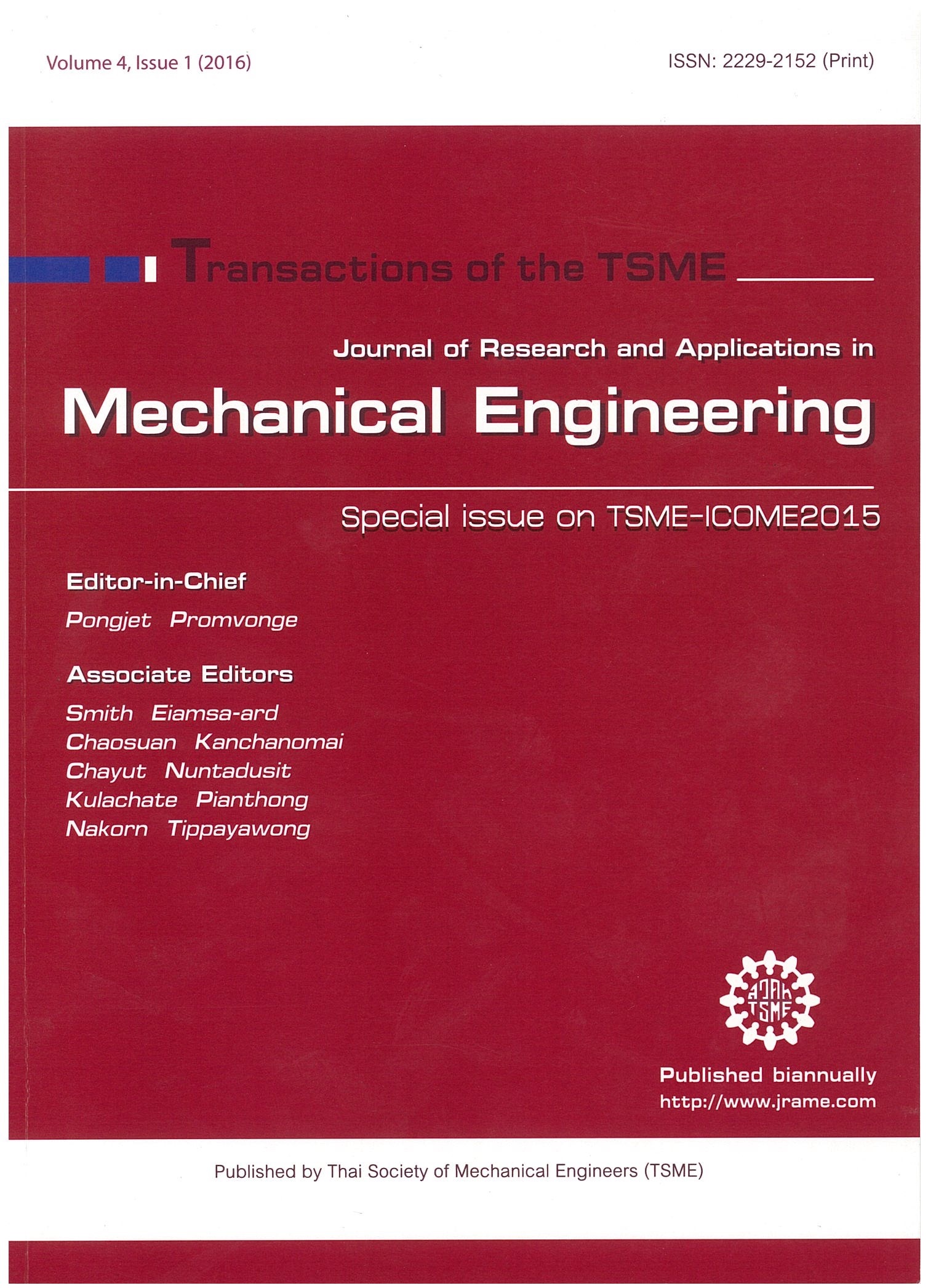Optimum design of organic Rankine cycle for low temperature heat sources
Main Article Content
Abstract
The paper presents a study of new technology, called “Organic Rankine Cycle” (ORC), which can be operated likely Steam Rankine Cycle (SRC) but it can take more advantage than SRC. ORC can generate electricity with low temperature heat sources such as geothermal energy or waste heat released from the industry. Nevertheless, the thermo-economic optimization of this technology is still required. Therefore, in this study, the optimum design of ORC system by matching equipment and selection of appropriated working fluid are need to investigate in order to obtain the cost effective from low temperature heat resource. The operating condition of each working fluid was firstly investigated to match with the temperature of the heat sources. From the result, the optimum working temperatures of each working fluid can be suggested. Then the system design was calculated with the parametric survey on two types of heat sources; flue gas from industrial boiler and geothermal based heat source, which their temperatures were lower than 300C. The variation of working fluids to obtain the optimum system with high thermal efficiency, high power output and short payback period were performed. The criterion of environmental friendly was one influence parameter taking into consideration to choose the appropriate working fluid in this study. The results can be concluded that R236ea, R245ca, R245fa were appropriate working fluid for ORC when it is applied with low temperature heat sources.
Article Details
This work is licensed under a Creative Commons Attribution-NonCommercial-ShareAlike 4.0 International License.
References
[2] Imran, M., Park, B.S., Kim, H.J., Lee, D.H., Usman, M. and Heo, M. Thermo-economic optimization of regenerative organic rankine cycle for waste heat recovery applications, Energy Conv. and Mang, Vol. 87, 2014, pp.107-118.
[3] Tchanche, B. F., Lambrinos, Gr., Franggoudakis, A. and Papadakis, G. Low-grade heat conversion into power using organic rankine cycles, Renewable and Sustainable Energy Review, Vol. 15, 2011, pp. 3963- 3979.
[4] Rayegan, R. and Tao, Y. X. A procedure to select working fluids for solar organic rankine cycles (ORCs), Renewable Energy, Vol. 36, 2011, pp. 659-670.
[5] Cengel, Y.A. and Ghajar A. J. Heat and Mass Transfer: Fundamentals and Applications, Mc Graw Hill 4th Edition in SI units, 2011, pp. 441.
[6] Qiu, G., Liu, H. and Riffat, S. Expanders for micro-CHP systems with organic rankine cycle, Appl. Therm. Eng., Vol. 31, 2011, pp. 3301-3307.
[7] Arvay, P., Muller, M.R. and Ramdeen, V. Economic implementation of the organic rankine cycle in industry, ACEEE Summer study on Energy Eff. in Industrial, 2011, pp. 12-22.
[8] Harada, K.J. Development of a Small-Scale Scroll Expander, Master of Science Thesis, 2010, Oregon State University.
[9] Mathie, R., Markides, C.N. and White, A.J. A Framework for the analysis of thermal losses in reciprocating compressors and expanders, Heat Transfer Eng., Vol. 35(16-17), 2014, pp. 1435-1449.
[10] Markides, C.N., Guarracino, I. and Mathie, R. Reciprocating Piston Expanders for Small-Scale ORC systems, Clean Energy Processes Group, Department of Chemical Engineering, Imperial College, London.
[11] Glavatskaya, Y., Podevin, P., Lemort, V., Shonda, O. and Descombes, G. Reciprocating expander for an exhaust heat recovery rankine cycle for a passenger car application, Energies, Vol. 5(6), 2012, pp. 1751-1765.
[12] Hsu, S., Chiang, H.D. and Yen, C. Experimental investigation of the performance of a hermetic screw-expander organic rankine cycle, Energies, Vol. 7(9), 2014, pp. 6172-6185.
[13] National Institute of Standards and Technology, Thermophysical Properties of Fluid Systems, URL: http://webbook.nist.gov/chemistry/fluid/
[14] The Engineering ToolBox, Ozone Depletion (ODP) and Global Warming Potential (GWP), Environment Properties, URL: http://www.engineeringtoolbox.com, January 23, 2015.
[15] Selvaraju, A. and Mani, A. Analysis of refrigerants properties for the ejector refrigeration systems, Inter. J. of Thermal Sciences, Vol. 43(9), 2004, pp. 915-921.
[16] Jin, H.S., Lee, B.G., Yang, D.R. and Lim, J.S. Vapor-Liquid Equilibria for HFCs + Propane, CFC Alternative Research Center, Korea Institute of Science and Technology.
[17] International Institute of Refrigeration, Classification of refrigerants, Designation and Safety Classification of Refrigerants.
[18] ASHRAE, ASHRAE Handbook-Fundamentals, Chapter 30: Thermophysical Properties of Refrigerants, 2009, pp. 24.



